Travel Through India on a Harley-Davidson
By Peter & Kay Forwood
India on a Harley (27/1/07 - 8/1/07)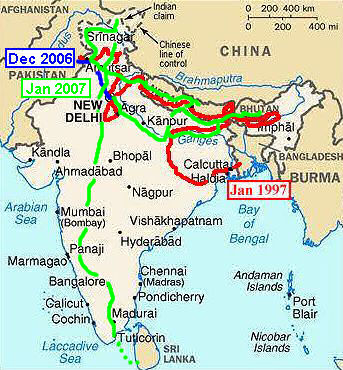
Distance 1144 km (485490 km to 486634)
This is part of the thirteenth section of our around
the world trip.
Complete Trip Overview & Map
Coming from the twelfth section India
27/1/07 We arrived at the airport early. Items purchased within the
last month prior to an overseas trip, and taken out of the country,
can be refunded the 10% goods and services tax, at least the goods
part. The motorcycle engine parts and other spares along with the new
computer gave us almost a $500 refund. We had also had difficulty taking
a dual fuel stove out of Australia last trip and so decided to inform
the authorities before check in that the stove was new and had not had
any fuel inside. In the confusion our bags were not correctly weighed,
and excess baggage was avoided. Feeling comfortable with the good luck
we boarded the half full aeroplane to India. On entering India from
Pakistan in December the authorities had placed a stamp in my passport
indicating that we had imported a motorcycle on a carnet. The purpose was
to prevent us leaving the country without taking the motorcycle with
us. Technically we are allowed to leave without the motorcycle but it
is not to be used whilst we are away. Rather than trying to convince the
authorities in India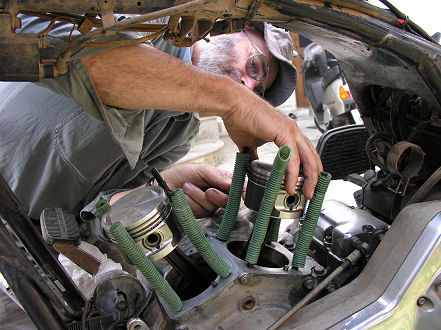 that the motorcycle was unusable, due to much of the engine
not being in the country after we left, we decided to cover the stamp
with an official looking sticker to disguise the event. Returning today
with half an engine, spares and a tyre we were anticipating a little
bit of explaining to the customs authorities at the airport. Luck was
still running with us as we were waved through and into Delhi. We were
at the same hotel in Paharganj by 9pm after a long day.
that the motorcycle was unusable, due to much of the engine
not being in the country after we left, we decided to cover the stamp
with an official looking sticker to disguise the event. Returning today
with half an engine, spares and a tyre we were anticipating a little
bit of explaining to the customs authorities at the airport. Luck was
still running with us as we were waved through and into Delhi. We were
at the same hotel in Paharganj by 9pm after a long day.
28/1/07 Delhi hasn't changed in the five weeks we have been away but
the same hotel seems a little more run down and the food is not quite as
good as it was, traffic appears more hectic, the streets dirtier and pollution
more engulfing. Coming directly from Australia rather than from a
year on the road is the difference. Businesses operate seven days a
week here although the starting time is normally not till 10 or 11 am.
The motorcycle had been moved to a different location. It was now at
the landlord's owner's house, parked outside in a laneway. It had to
be manhandled fifty metres from the shed we had left it in, as it needed
to be moved after the government sealed the building, the business was
being operated in a residential area. Although it had been necessary to
remove the locked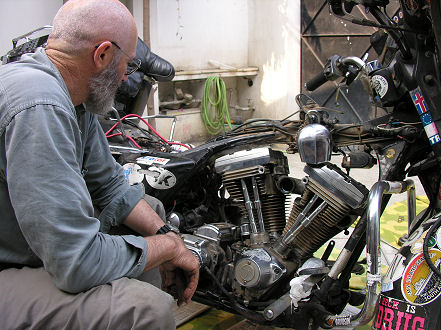 on motorcycle cover, all of our belongings seemed to be
still there and untouched. Refitted the repaired top box and reorganised
our belongings in preparation to start reassembling the engine tomorrow.
on motorcycle cover, all of our belongings seemed to be
still there and untouched. Refitted the repaired top box and reorganised
our belongings in preparation to start reassembling the engine tomorrow.
29/1/07 We were offered tea by the property owners where the motorcycle
had been stored before beginning to reassemble the engine in their
courtyard. The pistons were being placed on the conrods when the
securing clip sprung loose and dropped into the crankcase area and
disappeared into the bottom of the engine. It was a tense five minutes
while our magnetic probe searched the oily crank before locating the
clip. The generic ring compression tool we had brought couldn't be
modified to compress the piston rings so a bit of wiggling and gentle
manoeuvring with a small screwdriver was necessary to get them into the
cylinders. Other than that the pistons, heads and rocker covers proceeded
smoothly and were in place by mid afternoon. At the end of the day with
engine mount and oil filter in place and with spark plugs still removed
the engine was turned over, without any grinding or crunching noises,
so we felt we could sleep reasonably comfortably.
30/1/07  There is an obvious risk in rebuilding the engine
in India where we have no access to any parts we might have forgotten
or to be able to fix things we might break. It was back at the coal
face this morning. Again we were invited into the property owner's home,
this time to the brother's residence, offered tea and biscuits along
with friendly conversation, much of it on Indian politics and the closing
down of their leased businesses which they required for much of their
income and have been operating here for over thirty years. Many of the
auto businesses in the area have simply moved out onto the streets, having
nowhere else to go. Cars are now being repaired, engines and bodywork,
along the curbside as traffic moves past. The carburettor, exhausts and
petrol tank of our motorcycle went back and a few normal maintenance repairs
were done before the first engine start up in late afternoon. Whilst the
engine started easily the old low down noise was still apparent. We were
unable to take the bottom end of the engine back to Australia for repair
nor replace the conrod to piston bushings which need machining after
installation so perhaps the noise is coming from that region. Leaving
the motorcycle at its resting place for another night we returned
There is an obvious risk in rebuilding the engine
in India where we have no access to any parts we might have forgotten
or to be able to fix things we might break. It was back at the coal
face this morning. Again we were invited into the property owner's home,
this time to the brother's residence, offered tea and biscuits along
with friendly conversation, much of it on Indian politics and the closing
down of their leased businesses which they required for much of their
income and have been operating here for over thirty years. Many of the
auto businesses in the area have simply moved out onto the streets, having
nowhere else to go. Cars are now being repaired, engines and bodywork,
along the curbside as traffic moves past. The carburettor, exhausts and
petrol tank of our motorcycle went back and a few normal maintenance repairs
were done before the first engine start up in late afternoon. Whilst the
engine started easily the old low down noise was still apparent. We were
unable to take the bottom end of the engine back to Australia for repair
nor replace the conrod to piston bushings which need machining after
installation so perhaps the noise is coming from that region. Leaving
the motorcycle at its resting place for another night we returned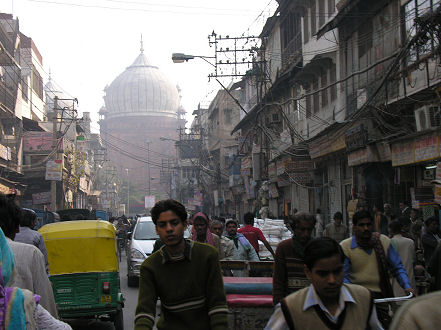 to our hotel not quite as relaxed with our days
efforts as we were last night.
to our hotel not quite as relaxed with our days
efforts as we were last night.
31/1/07 On the job again. Checked the oil level, which was a bit
low, and started the motorcycle. Yesterday's engine noise had somehow disappeared
but it was now running roughly. Later in the day we realised the
carburettor fuel flow needle had some dirt allowing the carburettor
to flood. We had cleaned out the petrol tank and fuel tap and perhaps
dislodged some dirt into the lines. Fitted a new front brake line, a
cheap Chinese alarm, adjusted the belt, tightened up the handlebars
which have been loose and packed up the panniers to take the motorcycle
for a ride back to our hotel. It ran smoothly as we were again reminded
of why we travel, to ride. Petra and Wim from the Netherlands, riding
their bicycles, had arrived just one hour before us and were settling
into their room. We had first met in Kerman in Iran and whilst we were
home with the family they have been cycling around Pakistan. Finding the
going difficult in India with the traffic and all the attention moving
slowly through this country involves they have decided to buy two Indian
Enfield motorcycles to travel here before returning to their
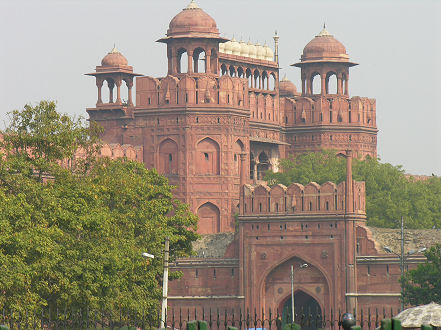 bicycles and heading towards South East Asia.
A little more relaxed tonight with the motorcycle jobs done we joined
them for a relaxing dinner.
bicycles and heading towards South East Asia.
A little more relaxed tonight with the motorcycle jobs done we joined
them for a relaxing dinner.
1/2/07 With just a couple of repacking jobs to do this morning we
uncovered the motorcycle, security parked outside our hotel, to find
the left mirror was broken, hit by the handlebars of someone attempting
to park another motorcycle too close. It has always surprised us in
countries where the people have so little that they don't respect property
that has value. Like the air conditioner installation people fitting
a new air conditioner in our room, they bent and forced the frame into
the slot damaging the cooling fins without any comment from onlookers.
Perhaps the not caring is the cause of these country's problems and not
the result. We accompanied Petra and Wim to look for two Enfield motorcycles.
In the suburb of Karol Bagh are located dozens of new and used motorcycle
shops. The Hero bicycle of India has become the Hero motorcycle as the population's
wealth has increased. Joint ventures of Japanese motorcycle companies have
put pressure on Enfield production who no longer controls the market. A
good second-hand Enfield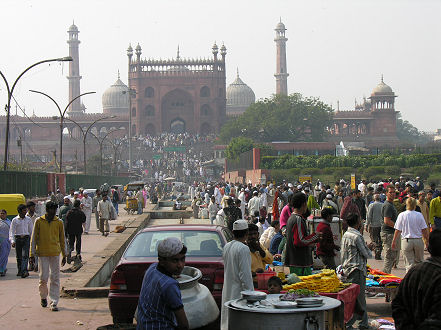 can still be purchased for less than $US 1000.
can still be purchased for less than $US 1000.
2/2/07 Delhi's Red Fort is its premier tourist attraction. Built in
the 17th century its walls, some over 30m high and a couple of km's long dominate
this region of Old Delhi. The two tiered entrance price, here ten times more
for foreigners than locals, common all over India, is a niggling distraction.
The view that it is the local's privilege and tourists have more money seems
a little out of date in a country which has more millionaires than Australia
and where no western country could get away with charging Indian tourists
ten times the entrance prices to our heritage sites because of racist or
discrimination legislation. This ongoing niggling complaint did not deter
us from enjoying the complex with its intricate inlay marble walls and ceilings
and its sheer size. We were however deterred from entering the Jama Mosque,
choosing to view the structure from the outside, as carrying a camera into
the mosque had a charge of $US 5.00 whether photos were taken or not, another
method of targeting tourists. Our last day in Delhi we relaxed in the afternoon
and looked forward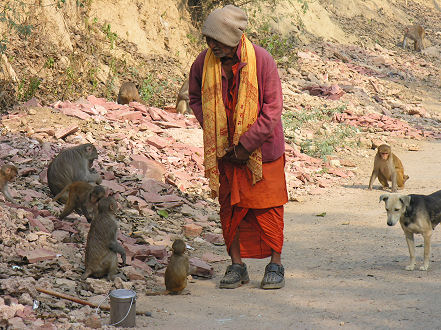 to getting on the motorcycle tomorrow.
to getting on the motorcycle tomorrow.
3/2/07 Overloaded as always, but now moreso with cold weather gear
preparing for a cold Bhutan. The motorcycle started easily and we headed
out of Delhi early, before the traffic became its usual bedlam. The
road whilst busy was a four lane all the way to Agra and mostly moved
freely except through the many towns. At the state border between Haryana
and Uttar Pradesh we were reminded that nothing changes fast in India as
the lines of trucks we remembered from our visit ten years ago, were still
occurring. It is not a country that allows easy movement of goods from one
state to another. On our last visit to the region we had visited Sariska Tiger
Reserve. At the time we had visited more than ten other national parks before
finally seeing a large male tiger walking across the grasslands at a
close distance. This time we did not visit the reserve as there are now
no tigers left there. In 2004 there were 18, but by 2005 there were no
tigers left. A similar story is occurring across the rest of India's tiger
reserves. Trapping and hunting for tiger products killing the last ones.
We had been unable to bring in oils from Australia due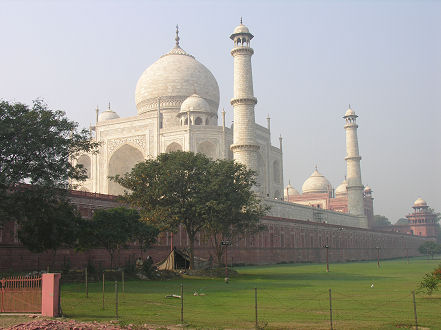 to airline regulations, so purchased local oils for the motorcycle.
India imports very few products as it imposes large duties. It prefers
to manufacture brand names under joint ventures or license. India is also
a country of copying, from medicines to designer clothes. The oil we
purchased was branded Pennzoil 20w-40w but was an unusual red colour and
seemed a bit thin. As the oil heated up in the engine, the oil pump was
not pumping enough pressure due to the oil's thinness, and the oil light
came on in traffic due to low pressure, with the engine running hot. We
hunted Agra for different oils. No foreign imports could be found, only
foreign companies, branded, made in India. Each one we opened was the same
red thin oil despite being branded differently making us suspicious that
these oils all came from the same source and were put into copied containers.
It is a worrying dilemma with the new engine.
to airline regulations, so purchased local oils for the motorcycle.
India imports very few products as it imposes large duties. It prefers
to manufacture brand names under joint ventures or license. India is also
a country of copying, from medicines to designer clothes. The oil we
purchased was branded Pennzoil 20w-40w but was an unusual red colour and
seemed a bit thin. As the oil heated up in the engine, the oil pump was
not pumping enough pressure due to the oil's thinness, and the oil light
came on in traffic due to low pressure, with the engine running hot. We
hunted Agra for different oils. No foreign imports could be found, only
foreign companies, branded, made in India. Each one we opened was the same
red thin oil despite being branded differently making us suspicious that
these oils all came from the same source and were put into copied containers.
It is a worrying dilemma with the new engine.
4/2/07 To help with the thinner oils and heat from the tight engine
we increased the size of the carburettor jet and retarded the engine
timing to hopefully make it run cooler. Our hotel overlooks the Taj
Mahal. Situated in the old narrow streets, where the original builders
of the structure lived. The hotels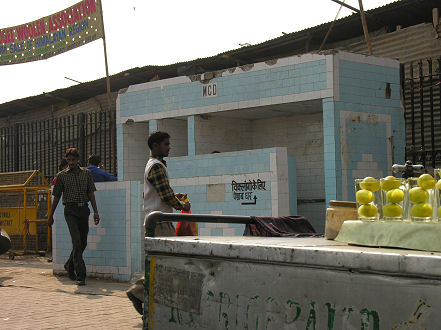 rooftop restaurant has some magnificent views of the Taj Mahal,
however this morning, despite being only a couple of hundred metres
away, it could hardly be seen. White, in the thick smoke of burning farm
residue for brick making, it fades to almost invisibility in the morning
light. Damaged recently by acid rain, no polluting vehicles are allowed
in it's immediate vicinity. Since arriving back in India last week we have
noticed an increased level of air pollution. The rains have stopped and burning
of rubbish and farm produce has clouded the air so the sun is not seen for
the first and last two hours of the day, shrouded in a thick smoke haze.
Having visited the place before we chose to avoid the crowds inside the Taj
Mahal walls and wandered quietly around outside. An old monk was feeding
some young monkeys and locals were bathing at a pump spigot situated alongside
the river, now just a black open sewer. The streetside urinals outflow into
open drains emptying with other rubbish into the watercourse. Viewed from
outside the height of the walls and extent of the grounds can be fully appreciated.
rooftop restaurant has some magnificent views of the Taj Mahal,
however this morning, despite being only a couple of hundred metres
away, it could hardly be seen. White, in the thick smoke of burning farm
residue for brick making, it fades to almost invisibility in the morning
light. Damaged recently by acid rain, no polluting vehicles are allowed
in it's immediate vicinity. Since arriving back in India last week we have
noticed an increased level of air pollution. The rains have stopped and burning
of rubbish and farm produce has clouded the air so the sun is not seen for
the first and last two hours of the day, shrouded in a thick smoke haze.
Having visited the place before we chose to avoid the crowds inside the Taj
Mahal walls and wandered quietly around outside. An old monk was feeding
some young monkeys and locals were bathing at a pump spigot situated alongside
the river, now just a black open sewer. The streetside urinals outflow into
open drains emptying with other rubbish into the watercourse. Viewed from
outside the height of the walls and extent of the grounds can be fully appreciated.
5/2/07 The many millions of cows that wander the streets unfearful
of ever ending up on a dinner plate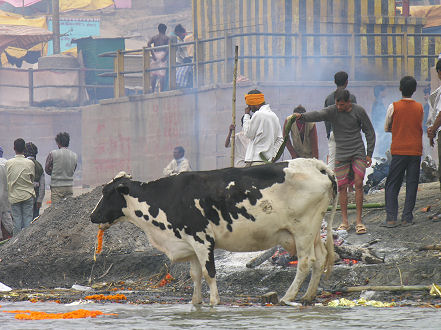 seem incongruous in a country where children are malnourished
or starve to death. Such are the vagaries of different religions. Hindu's
worship cows and only use them for milk and as beasts of burden, not
as meat. Many cows wander the streets of large cities not grazing on grass
their entire lives. A dropped banana skin, outside cabbage leaves, flowers
from weddings or the skin of carrots is what they scavenge along with
left over meals from restaurants. We are on a bit of a tight time frame
to meet up with our tour into Bhutan on the 17 Feb and headed out early
this morning towards Varanasi. The Grand Trunk or GT road as it is locally
known goes from Amritsar in the West to Kolkata (Calcutta) in the East.
It is the national highway but at times is a poorly maintained two lane
road. Massive improvements are being carried out but localised problems,
where it passes through villages, mean it has become a series of short
magnificent sections interspersed with atrocious bottlenecks. Travelled
450km to Allahabad today, narrowly missing a major bottleneck as a demonstration
was beginning in Kanpur. Traffic was already backed up crossing the train
line. Military were trying to move along the demonstrators who were
seem incongruous in a country where children are malnourished
or starve to death. Such are the vagaries of different religions. Hindu's
worship cows and only use them for milk and as beasts of burden, not
as meat. Many cows wander the streets of large cities not grazing on grass
their entire lives. A dropped banana skin, outside cabbage leaves, flowers
from weddings or the skin of carrots is what they scavenge along with
left over meals from restaurants. We are on a bit of a tight time frame
to meet up with our tour into Bhutan on the 17 Feb and headed out early
this morning towards Varanasi. The Grand Trunk or GT road as it is locally
known goes from Amritsar in the West to Kolkata (Calcutta) in the East.
It is the national highway but at times is a poorly maintained two lane
road. Massive improvements are being carried out but localised problems,
where it passes through villages, mean it has become a series of short
magnificent sections interspersed with atrocious bottlenecks. Travelled
450km to Allahabad today, narrowly missing a major bottleneck as a demonstration
was beginning in Kanpur. Traffic was already backed up crossing the train
line. Military were trying to move along the demonstrators who were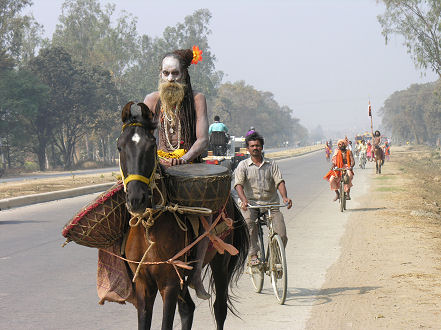 blocking vehicle movements at a strategic round about. We managed
to squeeze through as more and more vehicles crammed into the area causing
gridlock.
blocking vehicle movements at a strategic round about. We managed
to squeeze through as more and more vehicles crammed into the area causing
gridlock.
6/2/07 India is seen by around the world motorcycle travellers as
the most dangerous place to ride. The road rules, not formalised, just
observed due to the threat of death, are trucks and buses are the boss.
We were forced off the road many times as they overtook other trucks not
concerned that we had to brake and ride onto the verge to avoid them. The
Hindu caste system also plays its role as higher caste people, used to
getting what they demand, carry this attitude onto the roads and in big
4x4 style cars push motorcyclists, bicyclists and pedestrians off the
road. There are few roadsigns as they are expensive. Valuable for their steel
content they are often stolen. It all adds up to a stressful time on the
roads. With just 130 km to Varanasi today we took a relaxed approach, passing
one group of Hindu holy men and their followers on the road to their pilgrimage.
The leaders were on horse back, their followers either walking or on tractor
pulled wagons carrying all their belongings. On entering Varanasi a lone
pilgrim was prostrating himself, body length after body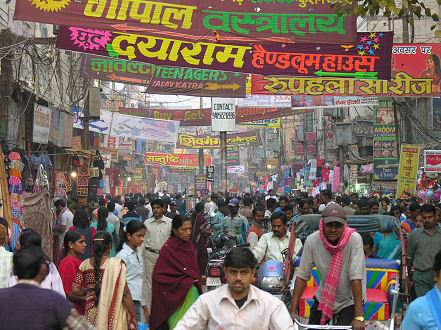 length along the ground, as he slowly moved towards the holy city.
The river is now at its low point and there are steps running down from
many of the palaces and buildings for a couple of kilometres along its
banks. It is here that the pilgrims come to wash away their sins and link
with their spirituality.
length along the ground, as he slowly moved towards the holy city.
The river is now at its low point and there are steps running down from
many of the palaces and buildings for a couple of kilometres along its
banks. It is here that the pilgrims come to wash away their sins and link
with their spirituality.
7/2/07 Uttar Pradesh is India's most populous state with 166 million
people living in this small area. Whilst its population growth rate
has slowed lately it is still struggling to support its people. Varanasi
is the most holy place a Hindu can die or be cremated. The two burning
ghats along the Ganges River cremate 3-4 hundred bodies a day by burning
them in the open, on individual log fires. Many more are cremated in the
government crematorium when the families cannot afford the large amount
of timber required. The narrow laneways leading to the river prevent vehicle
traffic and bodies are carried, raised on makeshift stretchers by family
members. The nearest male relative has his head shaved and arranges the
formalities. After preparing the fire it takes less than an hour by the
staff to reduce the remains to ashes which are later scattered into the
sacred Ganges River. The procedure continues around the clock.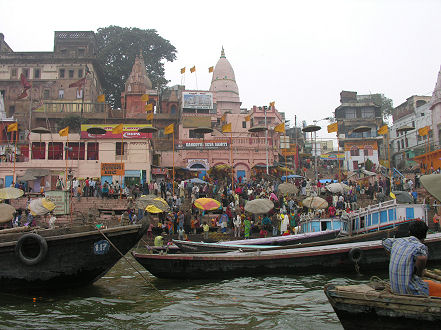 Female relatives are not allowed into the area, which is open
to the public, and many tourists come to observe the procedures. We
took a boat trip along the rivers edge watching pilgrims wash themselves
in the holy waters. People come from all over India just to bathe here.
Newly married couples come to celebrate and holy men live from their followers
offerings.
Female relatives are not allowed into the area, which is open
to the public, and many tourists come to observe the procedures. We
took a boat trip along the rivers edge watching pilgrims wash themselves
in the holy waters. People come from all over India just to bathe here.
Newly married couples come to celebrate and holy men live from their followers
offerings.
8/2/07 Headed north towards the Nepal border crossing. The smaller
road good with less traffic but had the usual distractions of being
an artery for everyone on the move. Houses, often just one deep with farmland
behind, lined it most of the way. A couple of water buffalo at each house
provide farm labour, milk and cooking fuel as their droppings are mixed
with waste straw. There are many large cities with more than a million
people in India and we passed through another one today. The congested
traffic, bottlenecked, had the motorcycle overheating again, as it idled,
gridlocked, and using the local watery oil. We arrived at the Nepal border
after travelling 330km by mid afternoon and left India without problems
at this busy border.
Move with us to Nepal or go to our next
visit to India
 that the motorcycle was unusable, due to much of the engine
not being in the country after we left, we decided to cover the stamp
with an official looking sticker to disguise the event. Returning today
with half an engine, spares and a tyre we were anticipating a little
bit of explaining to the customs authorities at the airport. Luck was
still running with us as we were waved through and into Delhi. We were
at the same hotel in Paharganj by 9pm after a long day.
that the motorcycle was unusable, due to much of the engine
not being in the country after we left, we decided to cover the stamp
with an official looking sticker to disguise the event. Returning today
with half an engine, spares and a tyre we were anticipating a little
bit of explaining to the customs authorities at the airport. Luck was
still running with us as we were waved through and into Delhi. We were
at the same hotel in Paharganj by 9pm after a long day. 
 on motorcycle cover, all of our belongings seemed to be
still there and untouched. Refitted the repaired top box and reorganised
our belongings in preparation to start reassembling the engine tomorrow.
on motorcycle cover, all of our belongings seemed to be
still there and untouched. Refitted the repaired top box and reorganised
our belongings in preparation to start reassembling the engine tomorrow. There is an obvious risk in rebuilding the engine
in India where we have no access to any parts we might have forgotten
or to be able to fix things we might break. It was back at the coal
face this morning. Again we were invited into the property owner's home,
this time to the brother's residence, offered tea and biscuits along
with friendly conversation, much of it on Indian politics and the closing
down of their leased businesses which they required for much of their
income and have been operating here for over thirty years. Many of the
auto businesses in the area have simply moved out onto the streets, having
nowhere else to go. Cars are now being repaired, engines and bodywork,
along the curbside as traffic moves past. The carburettor, exhausts and
petrol tank of our motorcycle went back and a few normal maintenance repairs
were done before the first engine start up in late afternoon. Whilst the
engine started easily the old low down noise was still apparent. We were
unable to take the bottom end of the engine back to Australia for repair
nor replace the conrod to piston bushings which need machining after
installation so perhaps the noise is coming from that region. Leaving
the motorcycle at its resting place for another night we returned
There is an obvious risk in rebuilding the engine
in India where we have no access to any parts we might have forgotten
or to be able to fix things we might break. It was back at the coal
face this morning. Again we were invited into the property owner's home,
this time to the brother's residence, offered tea and biscuits along
with friendly conversation, much of it on Indian politics and the closing
down of their leased businesses which they required for much of their
income and have been operating here for over thirty years. Many of the
auto businesses in the area have simply moved out onto the streets, having
nowhere else to go. Cars are now being repaired, engines and bodywork,
along the curbside as traffic moves past. The carburettor, exhausts and
petrol tank of our motorcycle went back and a few normal maintenance repairs
were done before the first engine start up in late afternoon. Whilst the
engine started easily the old low down noise was still apparent. We were
unable to take the bottom end of the engine back to Australia for repair
nor replace the conrod to piston bushings which need machining after
installation so perhaps the noise is coming from that region. Leaving
the motorcycle at its resting place for another night we returned to our hotel not quite as relaxed with our days
efforts as we were last night.
to our hotel not quite as relaxed with our days
efforts as we were last night.  bicycles and heading towards South East Asia.
A little more relaxed tonight with the motorcycle jobs done we joined
them for a relaxing dinner.
bicycles and heading towards South East Asia.
A little more relaxed tonight with the motorcycle jobs done we joined
them for a relaxing dinner.  can still be purchased for less than $US 1000.
can still be purchased for less than $US 1000.  to getting on the motorcycle tomorrow.
to getting on the motorcycle tomorrow.  to airline regulations, so purchased local oils for the motorcycle.
India imports very few products as it imposes large duties. It prefers
to manufacture brand names under joint ventures or license. India is also
a country of copying, from medicines to designer clothes. The oil we
purchased was branded Pennzoil 20w-40w but was an unusual red colour and
seemed a bit thin. As the oil heated up in the engine, the oil pump was
not pumping enough pressure due to the oil's thinness, and the oil light
came on in traffic due to low pressure, with the engine running hot. We
hunted Agra for different oils. No foreign imports could be found, only
foreign companies, branded, made in India. Each one we opened was the same
red thin oil despite being branded differently making us suspicious that
these oils all came from the same source and were put into copied containers.
It is a worrying dilemma with the new engine.
to airline regulations, so purchased local oils for the motorcycle.
India imports very few products as it imposes large duties. It prefers
to manufacture brand names under joint ventures or license. India is also
a country of copying, from medicines to designer clothes. The oil we
purchased was branded Pennzoil 20w-40w but was an unusual red colour and
seemed a bit thin. As the oil heated up in the engine, the oil pump was
not pumping enough pressure due to the oil's thinness, and the oil light
came on in traffic due to low pressure, with the engine running hot. We
hunted Agra for different oils. No foreign imports could be found, only
foreign companies, branded, made in India. Each one we opened was the same
red thin oil despite being branded differently making us suspicious that
these oils all came from the same source and were put into copied containers.
It is a worrying dilemma with the new engine.  rooftop restaurant has some magnificent views of the Taj Mahal,
however this morning, despite being only a couple of hundred metres
away, it could hardly be seen. White, in the thick smoke of burning farm
residue for brick making, it fades to almost invisibility in the morning
light. Damaged recently by acid rain, no polluting vehicles are allowed
in it's immediate vicinity. Since arriving back in India last week we have
noticed an increased level of air pollution. The rains have stopped and burning
of rubbish and farm produce has clouded the air so the sun is not seen for
the first and last two hours of the day, shrouded in a thick smoke haze.
Having visited the place before we chose to avoid the crowds inside the Taj
Mahal walls and wandered quietly around outside. An old monk was feeding
some young monkeys and locals were bathing at a pump spigot situated alongside
the river, now just a black open sewer. The streetside urinals outflow into
open drains emptying with other rubbish into the watercourse. Viewed from
outside the height of the walls and extent of the grounds can be fully appreciated.
rooftop restaurant has some magnificent views of the Taj Mahal,
however this morning, despite being only a couple of hundred metres
away, it could hardly be seen. White, in the thick smoke of burning farm
residue for brick making, it fades to almost invisibility in the morning
light. Damaged recently by acid rain, no polluting vehicles are allowed
in it's immediate vicinity. Since arriving back in India last week we have
noticed an increased level of air pollution. The rains have stopped and burning
of rubbish and farm produce has clouded the air so the sun is not seen for
the first and last two hours of the day, shrouded in a thick smoke haze.
Having visited the place before we chose to avoid the crowds inside the Taj
Mahal walls and wandered quietly around outside. An old monk was feeding
some young monkeys and locals were bathing at a pump spigot situated alongside
the river, now just a black open sewer. The streetside urinals outflow into
open drains emptying with other rubbish into the watercourse. Viewed from
outside the height of the walls and extent of the grounds can be fully appreciated.
 seem incongruous in a country where children are malnourished
or starve to death. Such are the vagaries of different religions. Hindu's
worship cows and only use them for milk and as beasts of burden, not
as meat. Many cows wander the streets of large cities not grazing on grass
their entire lives. A dropped banana skin, outside cabbage leaves, flowers
from weddings or the skin of carrots is what they scavenge along with
left over meals from restaurants. We are on a bit of a tight time frame
to meet up with our tour into Bhutan on the 17 Feb and headed out early
this morning towards Varanasi. The Grand Trunk or GT road as it is locally
known goes from Amritsar in the West to Kolkata (Calcutta) in the East.
It is the national highway but at times is a poorly maintained two lane
road. Massive improvements are being carried out but localised problems,
where it passes through villages, mean it has become a series of short
magnificent sections interspersed with atrocious bottlenecks. Travelled
450km to Allahabad today, narrowly missing a major bottleneck as a demonstration
was beginning in Kanpur. Traffic was already backed up crossing the train
line. Military were trying to move along the demonstrators who were
seem incongruous in a country where children are malnourished
or starve to death. Such are the vagaries of different religions. Hindu's
worship cows and only use them for milk and as beasts of burden, not
as meat. Many cows wander the streets of large cities not grazing on grass
their entire lives. A dropped banana skin, outside cabbage leaves, flowers
from weddings or the skin of carrots is what they scavenge along with
left over meals from restaurants. We are on a bit of a tight time frame
to meet up with our tour into Bhutan on the 17 Feb and headed out early
this morning towards Varanasi. The Grand Trunk or GT road as it is locally
known goes from Amritsar in the West to Kolkata (Calcutta) in the East.
It is the national highway but at times is a poorly maintained two lane
road. Massive improvements are being carried out but localised problems,
where it passes through villages, mean it has become a series of short
magnificent sections interspersed with atrocious bottlenecks. Travelled
450km to Allahabad today, narrowly missing a major bottleneck as a demonstration
was beginning in Kanpur. Traffic was already backed up crossing the train
line. Military were trying to move along the demonstrators who were blocking vehicle movements at a strategic round about. We managed
to squeeze through as more and more vehicles crammed into the area causing
gridlock.
blocking vehicle movements at a strategic round about. We managed
to squeeze through as more and more vehicles crammed into the area causing
gridlock.  length along the ground, as he slowly moved towards the holy city.
The river is now at its low point and there are steps running down from
many of the palaces and buildings for a couple of kilometres along its
banks. It is here that the pilgrims come to wash away their sins and link
with their spirituality.
length along the ground, as he slowly moved towards the holy city.
The river is now at its low point and there are steps running down from
many of the palaces and buildings for a couple of kilometres along its
banks. It is here that the pilgrims come to wash away their sins and link
with their spirituality.  Female relatives are not allowed into the area, which is open
to the public, and many tourists come to observe the procedures. We
took a boat trip along the rivers edge watching pilgrims wash themselves
in the holy waters. People come from all over India just to bathe here.
Newly married couples come to celebrate and holy men live from their followers
offerings.
Female relatives are not allowed into the area, which is open
to the public, and many tourists come to observe the procedures. We
took a boat trip along the rivers edge watching pilgrims wash themselves
in the holy waters. People come from all over India just to bathe here.
Newly married couples come to celebrate and holy men live from their followers
offerings.